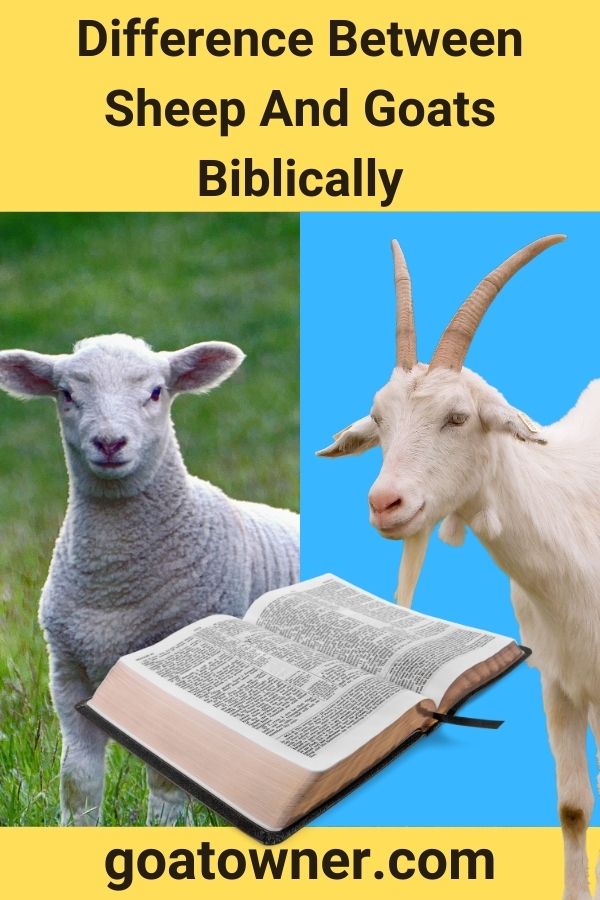In the Bible, animal imagery is one of the most commonly recurring motifs in the whole text.
Animals are used to embody an almost endless array of different spiritual meanings, and you could devote your entire career to delineating the mysteries and meanings of all the differences.
When it comes to two animals in particular, though, we often hear about them more than others—sheep and goats.
So often, Christianity is framed as a flock religion in which God is the shepherd.
But how are goats and sheep different in the Bible?
So, what are the differences between sheep and goats?
The basic distinction is about acceptance or rejection of the message of Jesus. Those who are to be saved, by accepting Jesus as their Lord and Saviour, are represented as the sheep. The lost and the damned, on the other hand, are represented as goats. It goes further, but this is the basic difference.
The Bible is an extremely old text, which has been through many translations and passed through many hands over the millennia.
This, naturally, means that interpretation of its language and imagery is very often up for debate.
Let’s look further into this.
What do sheep represent in the Bible?
The simple answer is many different things at different times.
Most of the scholarly debate surrounds the notion of Jesus as shepherd, though, and that has very natural implications.
Even today, priests and clergy people will refer to their congregations as flocks, as shepherds refer to their herds of sheep as flocks.
So, essentially, a sheep can have two basic meanings, particularly in the New Testament.
On the one hand, it can simply represent humanity as a whole.
Everyone is God’s creation, and thus they are all his sheep, his flock.
This is particularly important in relation to the human being Jesus, or the Son.
On the other hand, sheep represent a dichotomy between two kinds of person.
The saved and the damned.
Though you may be thinking of the caprine image of Satan as a horned, cloven-hoofed man-beast, do not get ahead of yourself.
This has come down to us mostly from medieval traditions, and there is nothing, really, of this in the Bible.
That said, goats do represent those who have not accepted Jesus as their Lord, and so are damned.
What do goats represent in the Bible?
Goats, again, are a common thread throughout the entirety of the Bible.
From Genesis to after the life and birth of Jesus, goats are essential imagery in the Bible.
Again, though, I just want to reiterate that you shouldn’t let your mind run wild with ideas about the caprine devil.
That said, there is one important thing which goats embody in the Bible: damnation.
But, more importantly, we understand goats in their relationship and opposition to sheep.
Just as you cannot appreciate light without dark, or good without evil, or black without white, you cannot understand salvation if you don’t understand damnation.
The sheep in the shepherd’s flock are the saved.
The goats are the damned, and embody those who have not taken Jesus’s message to heart.
The central thing, then, is that the goats are separated from the sheep.
Let’s look into that separation a bit further.
What does God separating the sheep from the goats mean?
This notion of separating the goats from the sheep is one that has seeped into our language and culture, and the language and culture of the last two thousand years.
You might say that, in the simplest terms, it is about judgement.
You are separating the ‘bad’ from the ‘good’.
Why precisely goats are seen as bad and sheep as good is an entirely other question, steeped in centuries of scholarly thought.
It’s important to remember how anachronistic attitudes have affected our interpretations over the years.
As goats were associated with the occult, they came to be associated with evil.
One story in the Bible, though, has goats as one group opposed to the sheep who are the followers of Jesus.
So, in this sense, at the very least the goats represent those who refuse to accept Jesus.
But this is not quite the same as outright evil.
You must remember that the Bible was written over many centuries by many different people, and has since been passed down over two thousand years to new interpreters.
The meanings are never simple—but in some stories the dichotomy is quite clear.
What is the difference between the sheep and goats in the Bible?
So, where does this leave us, then?
Well, it seems that the more important animal in the equation is actually the sheep.
The point is that they are the saved, those who are being led by Jesus to salvation and to avoid damnation.
These are who you want to emulate.
The goats, on the other hand, are simply those who have not been saved.
There are many reasons someone might not have been saved, and not all of them point to outright evil.
Ultimately, the sheep and the goats are two sides of the same coin: humanity.
There’s no simple answer to a big, scholarly question like this, really.
The current consensus is that the sheep and goats in the Bible, typically, represent the dichotomy of the saved and the damned.
However, both animals feature throughout the New and Old Testament, and obviously Jesus is not present in the Old Testament.
That said, much of what the New Testament does is fulfil the prophecy of the Old—so there is still parallels there.

